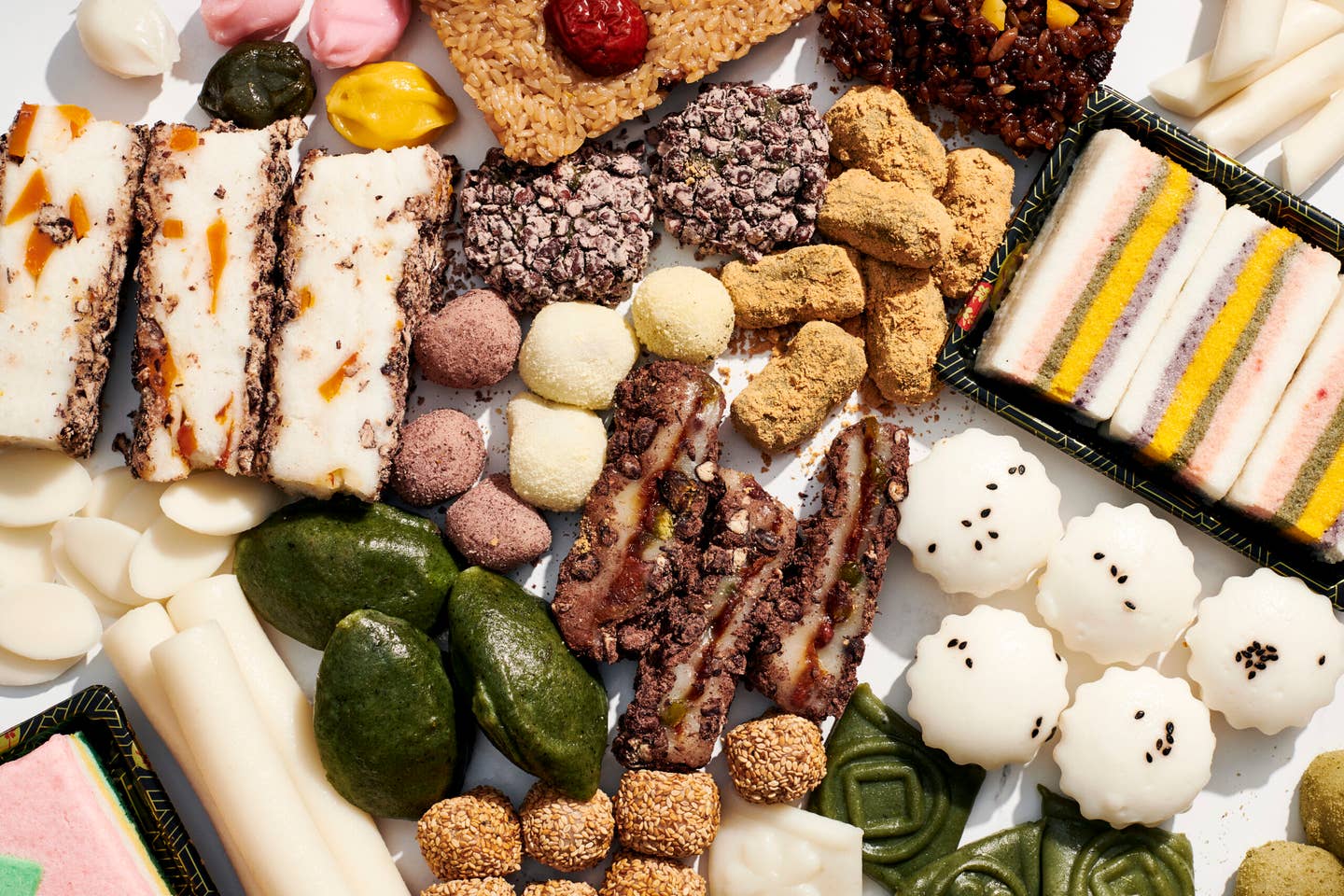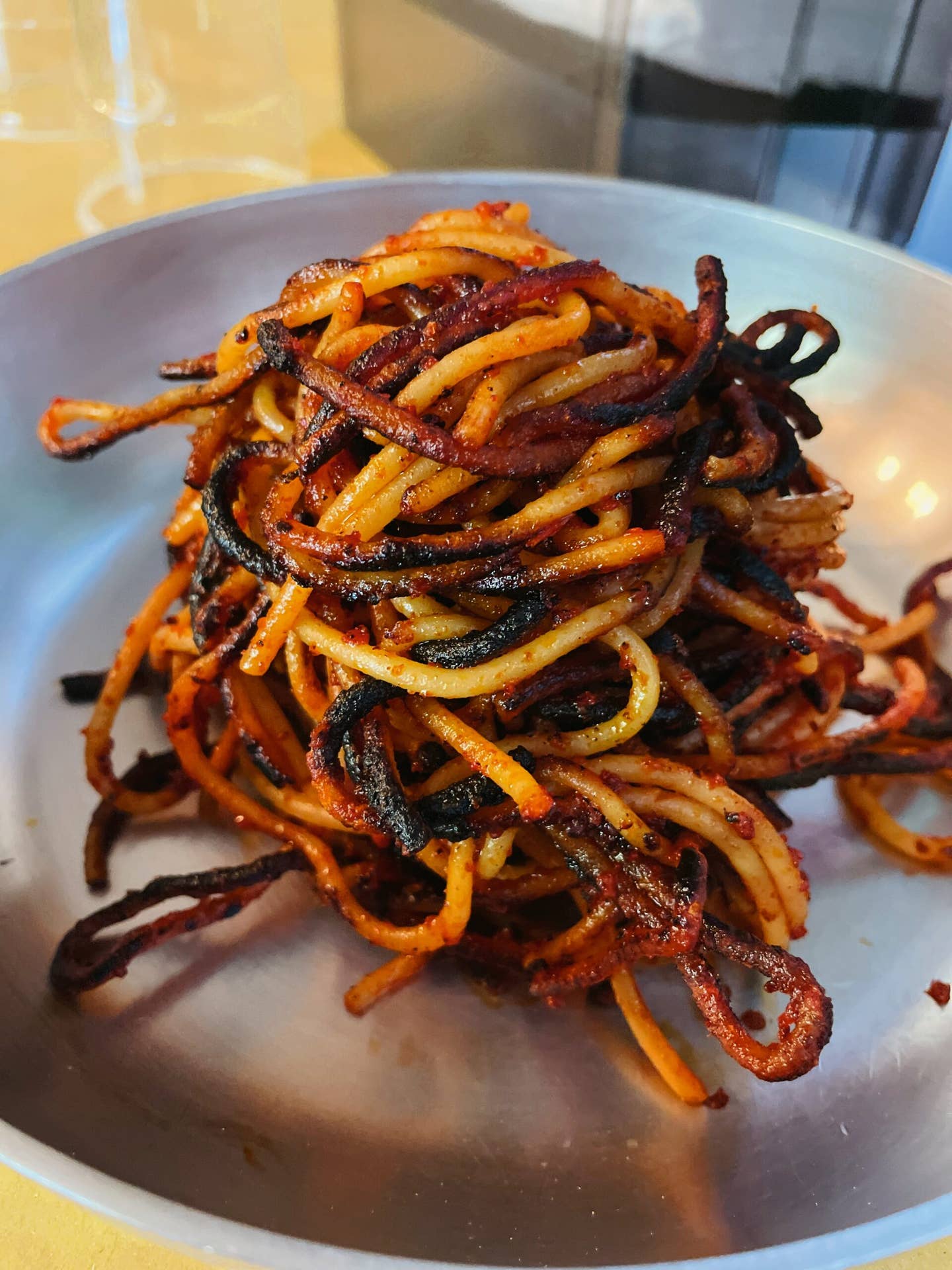
A Brief Guide to the Wide, Wonderful World of Korean Rice Cakes
Everything you need to know about tteok, from chewy injeolmi to crisp hotteok.
Tteok, or rice cakes, manifest in seemingly countless shapes, textures, colors, and flavors across the Korean peninsula. Both an ingredient and a dish, tteok can be turned into a full meal like tteokbokki (stir-fried rice cakes) or tteokguk (rice cake soup), or eaten on its own as a snack or dessert. The cakes are ubiquitous in every facet of Korean life, enjoyed as casual street food and at occasions like Seollal (Lunar New Year), Chuseok (a mid-autumn harvest festival), dols (first birthday celebrations), and funerals.
All tteok start with rice—either maebssal (short-grain rice) or chapssal (sticky rice, also known as glutinous or sweet rice). Maebssal produces a drier, more porous texture, while chapssal yields moister, more elastic tteok. The time-consuming process of transforming these grains into rice cakes generally falls into one of five broad categories: pounding, steaming, shaping, boiling, and frying. Depending on the technique, the texture can range widely from soft and powdery, to thick and chewy, to light and crispy.
Though industrial machines assist much of tteok production today, many people still make it by hand. Either way, it is a labor of love. Second-generation tteok maker Eunice Park, owner of the Korean bakery Lucky Rice Cake in Southern California, grew up lifting 50-pound bags of rice and hunching over steaming trays in her late father’s shop. Now, she carries on his legacy by not only offering traditional tteok but also taking family recipes in a new direction, with modern touches like delicately hand-piped flowers made of sweet bean paste.
“The rice cake isn’t just a product for me. It’s very symbolic,” says Park. After all, Koreans have been making and sharing tteok to express reverence, artistry, and jeong (a feeling of intense goodwill and deep loyalty) for centuries. The long-standing tradition of gifting tteok “has its roots in times when rice was scarce, meaning that a dense cake made of rice signified luxury, and thus celebrated a special moment or expressed gratitude,” write chefs Junghyun Park and Jungyoon Choi in The Korean Cookbook, their recently released tome on hansik (Korean food culture).
Today, growing global interest in Korean food—driven by forces like K-Pop, Korean dramas, and social media—has been raising the profile of this naturally gluten-free and often vegan food. “This isn’t just rice cakes anymore. It’s a whole culture,” declares Young S. Choi, the tteok maker behind Kung Sil Rice Bakery in Santa Clara, California, which supplies grocery stores in the San Francisco Bay Area with many of the classic varieties.
Eunice Park hopes that rice cakes can be a vehicle for welcoming more people to share in Korean cultural traditions. More widespread awareness and recognition might start with something as simple as using the Korean word tteok to properly name this class of foods. “When culture changes, the dictionary changes,” points out The New York Times food writer and former SAVEUR contributing editor Eric Kim, who's also the author of the cookbook Korean American. As Korea’s cultural influence (already enough of a phenomenon to warrant its own name, hallyu) continues to grow, the country’s staple foods, including tteok, are only becoming more widely available. Find tteok in the prepared foods section at a Korean grocer, tteokjips (rice cake specialty shops), or online. Here are some of the most popular varieties of tteok to look for—and what makes each distinctly delicious.
Pounded
Chapssaltteok, or “chaltteok” for short, is the category of tteok made by pounding cooked, cooled glutinous rice. Traditionally, this required a jeolgi—a giant mortar and pestle—but nowadays, machines usually do the heavy lifting. The sticky dough allows for fun variations in shape, texture, and filling.
This sweet treat is a soft rice-dough pouch filled with pat, or sweet red mung bean paste. Sometimes, the dough is pressed with a wood, ceramic, or bangjja (hand-forged bronzeware) stamp for decoration—or dressed up with appliqued pieces of dough, dyed naturally using ingredients like golden hobak (winter squash) pulp, pink songgi (pine-bark pigment), or green ssuk (mugwort leaves).
A dusting of red mung bean grinds or roasted soybean powder gives these remarkably soft morsels of pounded rice dough a delightfully nutty flavor. In stores, you’ll often find them in airtight cellophane packaging, which preserves their light, airy texture.
On Jeju Island, south of the Korean peninsula, stormy weather and limited land once made rice difficult to procure. Born from scarcity of rice, these craggy desserts feature pounded chajo (foxtail millet) rolled in gomul (crushed red mung beans). Note that omegi tteok hardens quickly and must be enjoyed fresh.
Steamed
As diverse as tteoks in this category may be, all are made possible by the power of steam. Sometimes that means pressing together whole steamed rice grains; other times, it involves steaming a pan of rice flour or rice dough, often along with other ingredients.
This subcategory of steamed tteok derives its name from siru, a large traditional earthenware steamer pot. Sirutteok is made by steaming a tray of rice flour and other ingredients, then cutting it into blocks. Red mung beans are a classic add-in, but green peas and baektae garu (ground yellow soybeans) are also popular; on Jeju Island, tteok shops use the rinds of their famous hallabong tangerines.
“White snow cake” tteok graces tables during baek-il, or the celebration of a newborn’s 100th day after birth. Eating baekseolgi tteok for this occasion signifies wishes of purity and health for the little one. Many tteok makers fashion the dough into a round shape to resemble a birthday cake.
For weddings, a first birthday, or hwangap (a 61st birthday, signifying rebirth after the completion of five 12-year lunar cycles), this square rainbow tteok marks the occasion. The cake’s five layers are traditionally white, pink, yellow, green, and grayish brown, usually derived from natural flavors like gardenia extract, cactus fruit, mugwort powder, and rock ear mushroom.
Red mung bean sirutteok is a staple at business openings, housewarming parties, and funeral banquets. In Korean folklore, red mung beans are believed to ward off evil spirits, while the red color symbolizes positive yang energy.
Empty a bottle of unfiltered makgeolli rice wine into a mound of rice flour before steaming the dough mix in a tray, and you get this shiny, spongy tteok with a yeasty tang. This tteok appears most often as a loaf or in a mini-muffin shape, often adorned with black sesame seeds.
Cooks make this nutritious tteok by mixing steamed sticky rice grains with a binding sweetener and a protein-rich assortment of fruits and nuts (think chestnuts, walnuts, jujubes, and dried cranberries). Cut into bricks, it’s a popular snack to bring on a hike or a day of errands. It’s also a staple during Daeboreum, the first full moon of the new lunar year.
Shaped
Much like pastas, shaped tteoks are formed into recognizable forms by machine, mold, or hand. Because they keep their shapes well, these tteok are often cooked, so they absorb the flavor of other ingredients.
Enjoy this large cylindrical tteok—made with just rice, salt, and water—dipped in some sesame oil or on its own. Eric Kim, whose father prefers garaetteok with honey and soy sauce, likes to roast it like a marshmallow. “It gets toasty-crispy on the outside, but the inside stays very creamy,” he explains.
Lovers of tteokbokki, the Korean street food typically bathed in gochujang, will recognize these rice cake batons, which soften as they simmer. While the spicy, saucy iteration of the dish is by far the most popular, you’ll also find these tteok stir-fried with soy sauce (ganjang tteokbokki) and shallow-fried in oil (gireum tteokbokki). According to Ji Hye Kim, a chef focused on bringing old food traditions from the Joseon Dynasty into the modern day, they also make a tasty substitute for pasta, like the cacio e pepe-inspired tteokbokki dish she serves at her Ann Arbor, Michigan restaurant Miss Kim.
Thin, elliptical medallions of bias-sliced garaetteok are a main ingredient in tteokguk, an anchovy broth-based soup that ushers in the Lunar New Year. It is “one of the most significant dishes in Korean tradition. On the first day of the new year, tteokguk was eaten as the first meal in tribute to ancestors,” write Junghyun Park and Jungyoon Choi in The Korean Cookbook.
Glistening dumplings loaded with pat (mashed red mung beans) or ggul kkeh (whole sesame seeds with crystalized honey), songpyeon often have a familiar half-moon shape, appearing in kaleidoscopic arrangements at Chuseok celebrations. Songpyeon translates to “pine tteok,” as the dumplings were traditionally steamed in a basket with pine needles, which prevented the songpyeon from sticking and also imparted a fresh scent. Sometimes, these tteok undergo additional steaming to set their shape. (A smaller, rounder version is called ggul tteok.)
Boiled
Gyeongdan, the only variety of boiled rice cakes, encases a sweet filling of red mung bean paste. After simmering in hot water, the tteok are rolled in crushed black sesame seeds or bean powders.
Fried
It’s hard not to love fried dough. The rice flour in these tteok gives them an irresistibly crisp and chewy texture.
Iron-pressed pancakes stuffed with cinnamon and sugar became popular across the peninsula when Qing Chinese merchants introduced them to Korea in the late 19th century. In the 1950s, Korean War refugees who fled south to Busan created ssiat hotteok, a version filled and covered with seeds and nuts.
Gaesong-juak
These eye-catching miniature donuts, which originated in the Kaesong region in present-day North Korea, are glazed with ssal-jocheong (rice syrup) and bedazzled with ingredients like pumpkin seeds, whipped cream, and candied persimmons. Once reserved for weddings and Chuseok, the donuts are now a treat for any day of the year—and an excuse to be creative.
Hwajeon
Believed to date back to the Koryo Dynasty (918-1392), hwajeon are circlets of fried dough adorned with seasonal flowers like azaleas, rhododendrons, pear blossoms, rose petals, and wild chrysanthemum. They’re a festive symbol of not only Samjinnal, the arrival of spring during the third month of the lunar calendar, but also Buddha’s birthday soon thereafter.
Recipes
Keep Reading
Continue to Next Story










